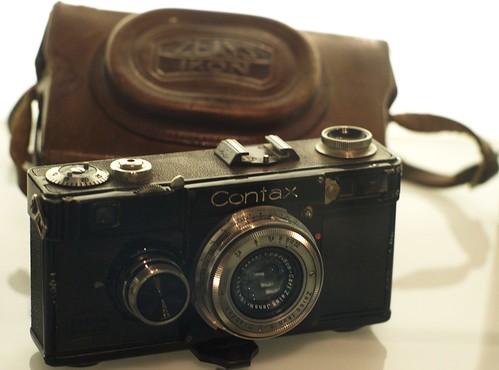
|
| Contax I from Zeiss collection image by U. Kulick (Image rights) |
Contax I[]
The Contax I was a high end 35 mm rangefinder system camera made by Zeiss Ikon to compete with Leica models. It was released in 1932.
The Contax I was Zeiss' answer to Leica's offerings in the 35mm market, one Leica effectively controlled since it helped to create it in 1925. An examination of the Contax I points to a perhaps frantic company rushing a technically superior product to market. It had a large number of technological advantages as compared to the Leica. It had a longer effective rangefinder triangulation base for better focusing. It had a bayonet lens mount (see Contax rangefinder lenses) instead of Leica's screw mount. It also had a removable back for loading film instead of Leica's blind hole film loading system. To go up against Leica's horizontal travel fabric shutter (max. speed 1/500th), the Contax had a vertical travel articulated metal shutter (max. speed 1/500th in the beginning, soon after 1/1000th), based on a design by Prof. Emanuel Goldberg, the chief designer before Küppenbender came. As it was made of (heavy) brass it was less vulnerable to sun burn. Lenses ranged from 2,8cm wideangle to 50cm tele in 1934. Together with close-up devices and more sophisticated tools for scientific use the Contax I can be called one of the first true system cameras in 35mm.
Unfortunately, the Contax I lacked in fit-and-finish, and it suffered from many reliability problems. This is evidenced by its heavy weight, and because of its harsh corners and box-like shape, as well as the various revisions that indicate a frantic company trying to manage its reputation. All Contaxes I were black, just some very few chrome versions, probably made on special demand, are known today.
From its introduction in 1932 to 1936 when the Contax II was introduced, the Contax I was a work in progress. There are no fewer than six iterations based on external features only. This is actually an underestimate. There were also many non-visible internal changes such as the location and physical layout of how the angular displacement of the lens couples to the rangefinder system. Other changes were meant to make the rangefinder system stay within specifications better. Earlier versions had a mirror-type rangefinder, about the last ones had already a prism similar to the Contax II/II. Later versions actually provided better focusing feedback to the user. Many of the cameras had shutter reliability problems and therefore were send back to the factory for a revision, today visible in the letter A preceding the serial number. Earlier cameras could also be upgraded from 1/500th to 1/1000 or including also the slow time mechanism, which was missing in the first models (so-called Zweigruppenverschluss / Two Groups Shutter versus the Dreigruppenverschluss / Three Groups Shutter). These were not small changes, and many of the still-working models are actually later revisions. These revisions were incorporated in the Contax II, a much more reliable camera that went through fewer iterations. This all might be a hint that Zeiss Ikon probably did a hasty entry in the market to compete with Leitz's Leicas.
Contax II[]
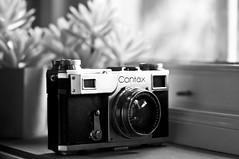
|
| Contax II image by Tomas Haande (Image rights) |
The Contax II was released in 1936 and was the successor of the Contax I. It was the first camera with a rangefinder and viewfinder combined in a single window. Its chief designer was Hubert Nerwin. These cameras were produced at the Ica factory in Dresden, together with all 35mm gear of that period.
The shutter design was completely changed, proving much more usable and reliable than the Contax I. Also the failure prone rewind mechanism was abandoned. In its overall appearance the Contax II/III were remarkable masterpieces in fit and finish, put together in a sleek shell that must have been an impressive sight in its time.
All Contaxes II/III were in chrome, only very few known to be black (Jena Contax II). Also the lens design changed to chrome.
New on the Contax II was also the fastest shutter speed of any 35mm camera on the market, of 1/1250. This speed was chosen by the designers for the sole purpose of having a speed faster than the Leica III of the day, but in reality was not of much use, as it was 1.5 f-stops faster than the previous 1/500 of the very first Contax I. Another difference is the lack of one second on the shutter dial. It nevertheless can be achieved by putting the dial to B and using the self timer, another beautiful add-on to the design with the Contax being the second regular production 35mm camera after the Contaflex to have this.
The Contaflex - introduced one year before the Contax II - was a derivative of the Contax I. It was a 35mm twin lens reflex with the same kind of shutter and a built in exposure meter. It was an extremely expensive camera, that tested some of the features that would later appear on the Contax II and III. It had interchangeable lenses with a specific lens mount.
Also the Super Nettel was based on the Contax I, with the same kind of shutter, but a folding body, a fixed lens and a short based rangefinder. It was intended to be a cheaper alternative. The Nettax was meant to be a cheaper alternative to the Contax II, it was a derivative of the Super Nettel with a rigid body and interchangeable lenses with a specific bayonet and a very limited range of lenses.
Contax III[]
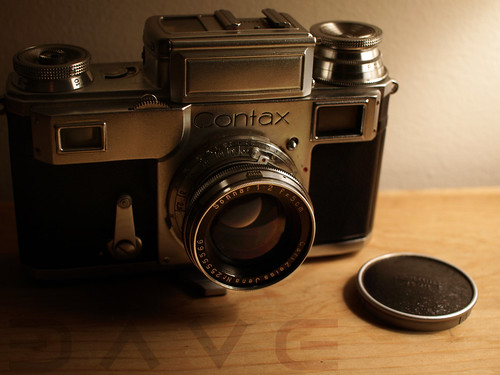
|
| Contax III (1939) w/ collapsible Carl Zeiss Jena Sonnar 50mm f/2 daveelmore (Image rights) |
The Contax III, also released in 1936 but with some delay, was a Contax II with an selenium exposure meter. It was one of the first 35mm cameras with a built-in exposure meter. During its production the sensitivity range of the exposure meter was slightly expanded.
Early Contaxes have the serial number inside on the bottom of the body and inside the detachable camera back, later ones for easier access also in the accessory shoe.
Both cameras - Contax II and III - were probably delivered to the military and some other countries like France, Latvia, Switzerland and Sweden until as far as April 1945 as some catalogues from Sweden suggest (O and M serial numbers). It is very questionable that Contax production was still going on at that time as bombing on Dresden, where the Contax had been produced, by Allied Forces became more frequent since Autumn 1944. Many wartime Contaxes II & III also found their way to the Fascist Naval Forces during the war, some of their lenses showing for the first time lens coating, a process which had been invented in the late thirties at Jena by Alexander Smakula for Carl Zeiss but had been kept a secret for several years.
After the war, the Soviet Military Forces (who had taken over in Jena after the US troops had left) ordered the remaining designers and staff to produce new drawings and tooling for the Contax II and III which had been lost during the bombing of Dresden and the damage of the ICA plant. These tools had to be prepared in very limited time by Carl Zeiss Jena at the Saalfeld tooling factory (SAG) near Jena where the first set of tools ahd to be set up for a test run. This particular camera, which is commonly referred to as "Jena Contax" (only about 25 Contax III models known), shows slight differences from the prewar version, most notably from the outside by a black ring around the selftimer lever and the word "Jena" in the accessory shoe above the serial number. According Werner Widder, who worked on these cameras, almost every part inside had been modified. The staff at Carl Zeiss Jena had to produce three sets of tools which were transfered together with some members of the staff as technical advisors to the city of Kiev, where they began the production of the Kiev rangefinder camera, as such a continuation of the Contax. Some very early Kievs were just re-labeled Jena Contaxes. An estimate goes that parts for around 2000 cameras were produced until October 1947 in Saalfeld.
At the same time, the Western part of the Zeiss Ikon company, based in Stuttgart, had already completely redesigned the Contax and launched the Contax IIa in November 1949 and Contax IIIa in March 1951.
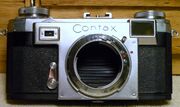
Contax IIa[]
With the Contax IIa, Zeiss Ikon introduced a brand new 35mm rangefinder camera to replace the aged Contax II/III, a design that had at times given trouble for its silk shutter straps which had to be renewed in certain intervals. Moreover, it was now mass produced in the Soviet Union as the Kiev II/III.
Hubert Nerwin had already started this new design at the end of the war before he had left for the U.S., but having only few trained technicians in Stuttgart right after the war, the introduction of the new camera was delayed. The Contax IIa/IIIa line of cameras were an engineering tour de force, with many new features such as flash synch, and a shutter that could be set to any speed with the curtains either tensioned or un-tensioned. Gone were the failure prone silk straps of the previous camera, in their place were nylon cords for opening the first curtain, and driving the flash synch, and heavy nylon strapping to drive the second curtain, and slow speed retard. Also gone were the straps running through a hole in the first curtain, which was the cause of most strap failure. This line of cameras could use any of the common film canister systems of the day, with one canister, or two, or could be used as a conventional shoot to the end, rewind style camera. The back and bottom of the camera came off to give easy loading, while the take up spool came out too for easy connection to the leader. Many believe that the Contax IIa/IIIa are, in terms of built quality, the finest camera line ever built (ZeissIkonRolleiRepair.com). However, as the two curtains travel independently, this design was more prone to shutter fading on the high speeds, something that was impossible on the prewar Contaxes.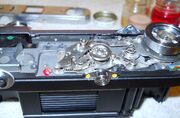
The rangefinder was similar to that of the II/III however the base was reduced, and through the high tolerance of the parts, it still coordinated well with all longer lenses that could be used without a reflex housing (135 mm). Bright by the standard of the day, the finder seems to be dim today, not much different from the usual digicam viewfinders and definitely less bright than the upcoming Leica M and Nikon S2, its main competitors in the coming years. The use of a huge prism like in the prewar Contax II/III in the rangefinder did not allow for a wider viewfinder as the camera would have become much larger - the aim though being to produce a smaller camera than the one before the war. For the same reason it was also hard to include different frames for different focal length like in the Leica M and Nikon SP - a fact, that eventually killed the Contax in the market with the arrival of the Leica M3, which dropped Contax sales to about a half of the year before. The rangefinder patch itself showed different tints toward red or green as Zeiss Ikon experimented with different surfaces for the prism.
Early cameras had the shutter speeds all painted black and are referred to as "Black Dial" (BD) cameras, and later models had the speeds from T-1/25 painted black, the 1/50 painted chrome yellow, and the speeds 1/100-1/1250 painted carmine red. Later cameras are often referred to as Color Dial (CD) cameras (starting around 1953) as it also implemented a standard international pc socket - this being the major revision of the camera until the end of its production in 1962. The colors were to remind the photographer that the speeds from T-1/50 were all flash synced, while those above were not--hence the stop light red color. On the black dial cameras there were two flash synch cords available one for use with flash bulbs (Z.I. Number 1361), and one for the strobe (Z.I. Number 1366). On BD cameras the shutter curtains had a built in delay, so they needed no bulb delay, while with strobe the attachment cable had a delay, so the strobe would fire at the appropriate time; this attachment cord was adjusted by the user, for their individual camera. With careful adjustment, strobe could be used at speeds of up to 1/100, if the shutter was adjusted perfectly! A speed unheard of in those days, for a 35mm focal plane shutter camera. Leica by comparison, had the ability to only be synched at the 1/25 of a second setting, and accidentally bumping the delay dial, would cause the flash to not synch at all.
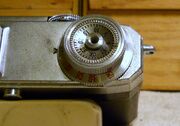
Lenses available for the IIa/IIIa were considered by many to be the best lenses of the era and are still sought after by users today. They included (all lenses made after WWII):
- 21mm f:4.5 Biogon, Carl Zeiss (Oberkochen, at the time the widest lens available for any 35mm camera)
- 2,5cm f:4 Topogon, Carl Zeiss Jena (CZJ)
- 35mm f:2.8 Biogon, Zeiss Opton, Carl Zeiss (only these Biogon 35 mm West German lenses fit the postwar cameras!)
- 3,5cm f:2.8 Biometar, Carl Zeiss Jena
- 35mm f:3.5 Planar, Carl Zeiss
- 5cm f:1.5 Sonnar, Carl Zeiss Jena, Zeiss Opton, Carl Zeiss
- 50mm f:1.5 Sonnar, Zeiss Opton, Carl Zeiss
- 5cm f:2 Sonnar, Carl Zeiss Jena
- 50mm f:2 Sonnar, Zeiss Opton, Carl Zeiss
- 5cm f:2.8 Tessar, Carl Zeiss Jena
- 5cm f:3.5 Tessar in collapsible mount, Carl Zeiss Jena
- 50mm f:3.5 Tessar in non-collapsible mount, Carl Zeiss
- 7,5cm f:1.5 Biotar, Carl Zeiss Jena
- 8,5cm f:2 Sonnar, Carl Zeiss Jena
- 85mm f:2 Sonnar, Zeiss Opton, Carl Zeiss
- 8,5cm f:4 Triotar, Carl Zeiss Jena
- 85mm f:4 Triotar, Zeiss Opton, Carl Zeiss
- 11,5cm f:3.5 Panflex Tessar, Carl Zeiss Jena
- 13,5cm f:4 Sonnar, Carl Zeiss Jena
- 135mm f:4 Sonnar, Zeiss Opton, Carl Zeiss
Flektoskop, Flektometer, or Panflex mount only:
- 18cm f:2.8 Sonnar (CZJ)
- 30cm f:4 Sonnar (CZJ)
- 50cm f:8 Fern (CZJ)
Some other third party lenses have been made (Old Delft, Sankyo-ku, Nikon Kogaku, Zunow, Voigländer e.a., for details see Contax rangefinder lenses). It is of interest to note that today there are many suppliers for Contax lens to Leica thread mount (LTM) and M mount adapters, but none supplying LTM, or M mount adapters for the Contax! In todays market, the most sought after lenses are those made in West Germany (Zeiss Opton, Carl Zeiss) in chrome mounts, while the East German Carl Zeiss Jena, mostly aluminum mount lenses, are not much in demand. Optical quality however should be widely the same, depending on their present condition.
With this line of cameras Zeiss Ikon had hoped to finally put an end to Ernst Leitz's Leica, but Leitz introduced the M line, with a viewfinder/rangefinder that could not be matched by any other camera, a quieter shutter, advance lever and (provided careful use or regular inspections) a simpler and more dependable shutter design - the rest is history. From around 1957 there are no more Contax prototypes known from Zeiss Ikon, as they started to concentrate on the upcoming SLR market with the Contarex.
Contax IIIa[]
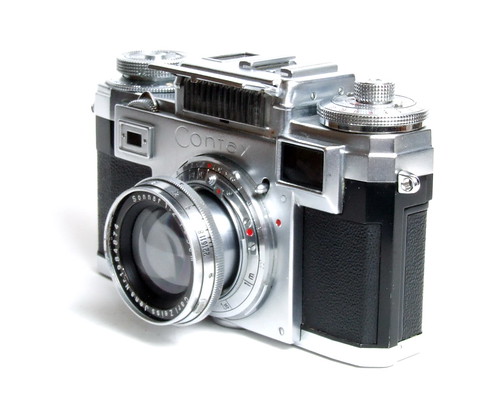
|
| Contax IIIa c.1956,color dial w/ Carl Zeiss Jena Sonnar 50mm f/2 image by Süleyman Demir (Image rights) |
See also the article Contax IIIa.
Contax IIIa is the same camera as the Contax IIa with an uncoupled selenium light meter. Compared to the prewar Contax II and III, the IIa and IIIa used the same lens mount with a completely re-engineered shutter mechanism, new body, and much improved chrome finish.
On earlier version IIa and IIIa cameras, all the shutter speeds on the dial in were black, and they are commonly called Black Dial, similar to the Leica IIIf black dial and red dial cameras. Later model Contax IIIa cameras added a standard pc flash socket and had the speeds 1/25-T painted black, the 1/50 painted chromate yellow, and the speeds from 1/100-1/1250 painted red. The Color Dial cameras were in production longer than the Black Dials, 1954-62 vs. 1950-54. The earlier black dial Contax IIa and IIIa have two separate flash synch cords, one for use with flash bulbs (no built in delay, 1361) and one for use with strobe (Vacublitz, 1366) with a variable delay, to allow the flash to be timed to the individual camera. Until the mid-fifthies there have been some prototype designs with changes on the exposure meter. Obviously, it was too expensive and difficult to update the rangefinder so it could battle against the Leica M3 as the prism used could not be enlarged without changing the whole camera body.
The Contax IIa and IIIa were/are a professional quality 35mm rangefinder camera system, with a large system of lenses and accessories, that some considered the best 35mm lenses produced during the 1950's. The Contax IIa and IIIa also has superb mechanical fit and finish, many believe better than even the legendary Leica M3, and vastly superior to the Screw Mount Leica, or the many copies. None the less the Leica product won the Rangefinder war, and the Contax ceased production in 1962 and was replaced by the Contarex SLR.
Bibliography[]
- Barringer, C. and Small, M. Zeiss Compendium East and West — 1940–1972. Small Dole, UK: Hove Books, 1999 (2nd edition). ISBN 1-874707-24-3.
- Otto, Bernd K. "Von der Carl Zeiss Jena-Contax zur Kiev", Photo Deal III/2001 (www.photodeal.de )
- Widder, Werner "The early postwar years at Carl Zeiss Jena", Journal of the Zeiss Historica Society, Vol.25, No.1 Spring 2003 (Zeiss Historica Society )
Links[]
In English:
- in Frank Mechelhoff
- in Contax IIa-IIIa serials
- in PhotoForum
- Zeiss Ikon Contax Rangefinder Lens Information Guide
- Biography of Heinz Küppenbender, chief developer of the Contax at The Zeiss Historica Society
- Contax I and Contax II/III at Cameraquest
- Contax I at Camerarepair.com
- Repair notes in Rick Oleson's website:
- Contax (II-III) shutter ribbons (also applies to Kiev 35mm rangefinder models)
- Contax IIa shutter CLA
- Make a takeup spool for your Contax or Kiev (by Henry Fisher)
- Contax II listed at number 16 in Jason Schneider's Top 20 Cameras Of All-Time on Shutterbug.
- Contax and other Zeiss Ikon patents
In French:
- Lionel's Zeiss Ikon Contax II overview at 35mm-compact.com
- Zeiss page at www.collection-appareils.com by Sylvain Halgand
In Japanese:
- Archiv Zeiss / Exakta by Mori Ryōsuke (with some English)
| Zeiss Ikon Classic Cameras |
|---|
| Contax | Contaflex (TLR) | Super Nettel | Nettax | Tenax II | Tenax I | Ikoflex | Super Ikonta
Contax S | Contaflex (SLR) | Contarex | Icarex | SL706 |